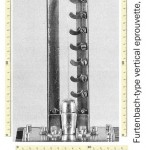
Asst. Professor Steven Walton (Social Sciences) was noted for his contribution to an ongoing project on the “Origins of Firepower” at the Royal Armouries and National Firearms Centre, Leeds [UK] in the Jan. 17-23, 2015 issue of New Scientist. In “Do it Again: What can we find out by re-enacting the science of yesteryear” [paywall*] (pp. 31-35), Richard Webb reported on replication work with early gunpowder testing apparatus being undertaken by Haileigh Robertson, a Ph.D. student at the University of York, and one of Walton’s advisees. Robertson is exploring the philosophical and technical knowledge about gunpowder int eh early 17th century for a Ph.D. in the history of science, and Walton, an expert on historic gunpowder, built a replica of Joseph Furttenbach’s eprouvette from 1627 (see image) for her to use in testing. The New Scientist article says of their work:
Today Robertson is aiming to repeat the eprouvette work using a replica device built by historian Steven Walton of Michigan Technological University in Houghton. It has two vertical supports about 60 centimetres high, with a post suspended between them. Attached to the bottom of the post is a brass lid which sits atop a small powder chamber and priming pan. When gunpowder is ignited in the powder chamber, the force of the explosion should propel the brass lid and post up past a series of ratchets that flip up, and then catch the lid as it begins to fall. The height the lid reaches is a measure of the gunpowder’s relative potency. Robertson’s collaborator Peter Smithurst, an emeritus curator of firearms at the National Firearms Centre, first packs the chamber with modern “black powder”. Technician Trevor Weston approaches cautiously with a long lit taper. I stand ready with the video camera. “I wouldn’t want to stand too close,” says Robertson, “until we know what it does.” What it does, besides make an almighty flash and bang, is hard to discern at first. But when the smoke disperses, the lid is balancing 13 ratchets up, half a metre off the floor. So far, so good. Less successful are gunpowder mixtures prepared using old recipes by Smithurst, a trained chemist. There is the odd fizzer like a Roman candle, and quite a few proverbial flashes in the pan. No one is sure why these mixtures don’t work as well – perhaps the modern stuff is finer-grained, with a larger surface area to encourage ignition. Or maybe the samples have got damp somehow. Archaeologists and historians alike want to understand the factors affecting the potency of early gunpowder. The power and range of early guns depended on the energy it could generate, so gunpowder influenced not only the design of cannons and armour, but also the evolution of battlefield tactics. By reproducing these experiments we get a feel for what was possible – and an idea of the frustrations.
Further experimental and simulation work is planned.
* online this is part of a series of “Reliving five eureka moments lost in history”